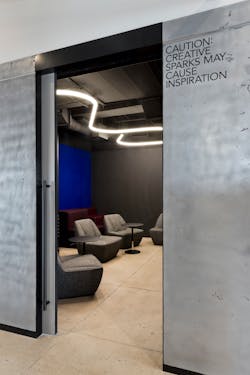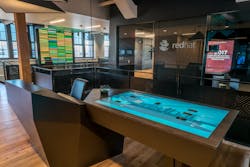What motivates people to return to the office?
Employers and people who own and manage office space have been trying to answer that question for three years now. Many reasons factor into why employees may or may not choose to work from a central office, but one key reason is within your control—whether the office offers something people cannot get at home.
Three years after the COVID-19 pandemic began, most remote workers have hit a comfortable groove with work-from-home life. But there’s no easy answer to providing the things home is missing—in-person collaboration, communication gaps between in-person and remote workers, and redundant technology that’s not easy to scale down to one person’s home. Smart integration of technology can support a workplace strategy that accommodates many different working styles and personality types, ultimately helping draw people back to the office.
Tips for Integrating Tech Intelligently
Smart tech integration starts in the earliest planning stages, said Scott Spector, principal of Spectorgroup. Technology experts, such as your IT department or audiovisual consultants, need to be hired right away “because they actually dictate the aesthetic of the architecture that happens, along with what’s needed from a technology support viewpoint,” Spector explained. “We have to accommodate them within the overall design. We may have a client who wants a 100-inch screen in their conference room versus another one who wants a 65-inch screen. All of those parameters need to be known during the schematic design process, not later on where it typically was years ago.”
People need to know that when they make the journey into the office, they’ll have seamless access to robust technology, added Regan Donoghue, senior principal of strategy for Unispace.
“When I think about technology, it’s the experience,” Donoghue said. “The number one frustration people have when they come into an office is the inability to connect with technology. It’s also important that you don’t embed it fully into the built environment because technology evolves … What I recommend is planning ahead for that. Plan ahead for flexibility and the user interface with the technology you choose.”
Technology and Workplace Culture
Integrated well, technology can enhance workplace culture—another aspect of the office that’s not easily replicated at home. Think about how your use of technology reinforces the overall culture. What is your office saying about you to visitors and employees?
“You’re letting people know ‘We are invested in the future of work. We are committed to this,’” Donoghue said. “A lot of companies that choose not to invest in technology right now run the risk of looking antiquated. You run the risk of someone coming in and seeing those ’90s desks.”
Working from home offers the option of having control over your own environment, Donoghue added: “My Internet is working as fast as I want it. I can make calls if I want. I have the privacy I need. These are all the things companies are fighting against now—they’re not fighting other companies, they’re fighting the status quo of staying home, and we have a strong bias to not change.”
To present a clear alternative to employees’ homes, think about how your office offering can evolve. “People have technology at home that works for certain things, but they don’t have the cool collaborative tech tools,” Donoghue said. “We don’t have digital whiteboards at home that are fun and integrative. Think about some of the really cool technologies out there that are more toward the future of work and that people are excited to engage with.”
Spectorgroup’s new headquarters on the 19th floor at 200 Madison Ave. in New York City makes carefully considered use of technology to create a cultural hub that empowers visitors and clients to connect with the firm. The office contains spaces of all sizes, from a large commons where people start their office experience to five sizes of conference rooms that accommodate varied sizes of gatherings. “If there’s one person who walks into this office and complains that they don’t have a place to go, I’d be shocked,” Spector remarked.
Futureproof Your Tech Selections
Technology evolves so quickly that futureproofing may seem like an impossible concept. However, strategic design can accommodate both today’s and tomorrow's tech without requiring drastic changes in the future. Spectorgroup recently completed a project with four 100-inch televisions fitted together.
“In the future, that could even expand, so you don’t want to build them in. You don’t want to create them with recessed spaces anymore,” Spector said of the TV wall. Today’s ultra-flat screens ensure that the screens lay on the wall without too much bulk behind them. “It needs to be designed as a flush look across the board, because it could be 100 inches one day, 65 inches the next day or a combination of 20 of them because a better TV came out. You have to be able to flip both ways.”
Hybrid workspaces may not have dedicated spaces for each employee, requiring scheduling technology. Spectorgroup uses Robin software to schedule its conference spaces. “We don’t have kooky signs on our windows. We don’t have touchpads that are obsolete in a year,” Spector said. “It’s software-based, and we manage that software. We also have displays on the desktop that say, ‘This is Scott Spector’s room from 10 to 11 a.m.’ That’s worked for us, and we’ve also introduced it to many of our clients.”
Put yourself in the employees’ shoes when you are looking at putting in new tech, whether it’s hardware or software, Donoghue advised. “Take that journey yourself when you’re looking at the product,” she said. “Don’t let the salesperson sell you on it. Go in and try to use it. Pretend you’re an employee going in for the first time, the IT person is gone for the day, and you have to present. See if it works, and you can see if it makes sense for your company.”
Above all, your tech plans should focus on redundancy, Spector added. Connecting in your office—and staying connected—should be easy, seamless, and issue-free. Ultimately, it doesn't matter what systems you choose to invest in if you don’t maintain and update them.
“You need to make sure your air conditioner is serviced once a year, because if you skip a year, you know it’s going to break the following year—and whose fault is that? It’s ours,” Spector said. “You need to be responsible, accountable and follow through, and that’s equally as important as the technology you invest in.”





